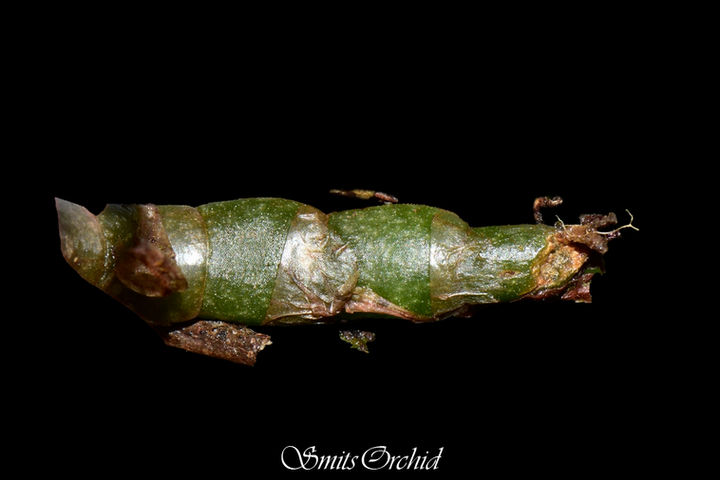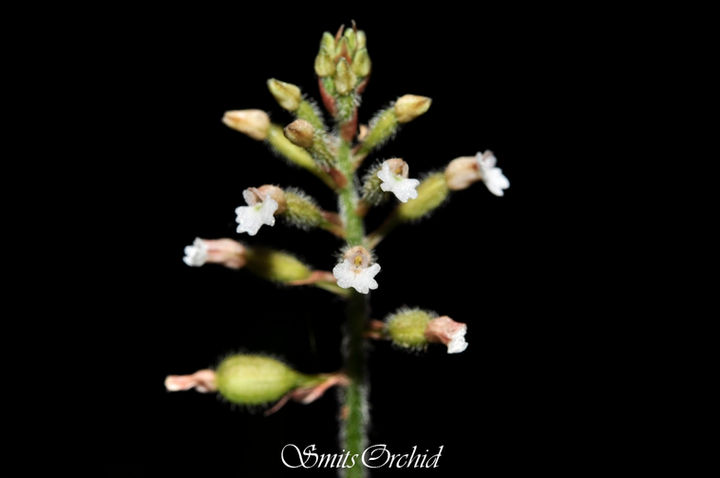
Cheirostylis Blume
Subfamily: Orchidoideae
Tribe: Cranichideae
Subtribe: Goodyerinae
Salient Features:
-
Ecology: Terrestrial or lithophytic rarely epiphytic herb
-
Rhizome creeping having few to many internodes terete or moniliform
-
Roots when present fleshy villous when absent replaced by internodal rhizoids on rhizome
-
Stem short or elongated terete or moniliform
-
Leaves scattered on stem or subrosulate, glabrous sometimes withered during anthesis petiole short sheathing at the base; lamina obliquely oblong, ovate-laceolate or suborbicular with white or silver band on midrib
-
Inflorescsence few to many flowered pubescent rarely glabrous; peduncle elongated with sheathing bracts
-
Flowers small, resupinate, glabrous or pubescent
-
Sepals connate forming sepaline tube, glabrous or pubescent, dorsal sepal usually connate to it’s entire length with lateral sepals, when free forming concave hood along with petals, Lateral sepals connate enclosing base of labellum
-
Petals membranous, obliquely linear-oblong to spathulate to rhombic, upper margin agglutinate to dorsal sepal and lower margin adnate to lateral sepals
-
Labellum without spur, attached to the base of column, saccate at the base; hypochile shallowly saccate with 2 or more calli inside; mesochile short or elongate sometimes with folded margins; epichile 1-2 lobed lobules entire or lacerate
-
Column slightly dilated, rostellum deltoid, deeply bifid; stellidia 2 parallel to shorter, equal in length or loner than rostellum;Stigma 2 lobed paced laterally near base of rosteelum on apical corner of column; Anther ovoid to ovoid-laciform 2 loculed; pollinia 2, cylindrical, suclavate sectile caudicle short, tegula semi-trasparent
-
Capsule pubescent or glabrous cylindric- fusiform

Cheirostylis parvifolia Lindl.
In Edwards's Bot. Reg. 25(Misc.): 19 (1839)
Cheirostylis seidenfadeniana C.S.Kumar & F.N.Rasm. in Nordic J. Bot. 7: 409 (1987)
Etymology: Name is derived from Latin ‘parvus’ (little) & foilus (leaved) referring to small size of leaves of this plant

Ecology: herb growing under dark shades of trees among mosses on humus rich soil on rock Also it grows on moist trunks of Mememcylon umbellatum Burm f. & Careya arborea Roxb. in moist evergreen forest
Terrestrial herb 5-20cm tall

Rhizome: 3-7cmlong 4-6cm in diameter pale green creeping sometimes slightly moniliforms or with thickened internodes
Roots: minute fibrous

Stem: 2-7cm long, 4-8 cm in diameter pale brownish green, unbranched, glabrous
Leaves: 2-8cm, upper smaller, withered during flowering
Glabrous petiolate petiole 0.3-1cm, sheathing base. Acute or acuminate apex, brownish green, 3-5 nerved

Inflorescence : terminal raceme, many flowered, sometimes secund, glandular, pubescent Peduncle 2 to 10cm pale green with 2-3 sheathing bracts0.8-2.5mm semiamplexicaul, acuminate light pink, pubescent 1-veined.

Floral bracts 5-8x1.8-2.5mm, semi amplexicaul, ovate acuminate, sparsely pubescent,1-veined
Flowers: 0.8-1.3cm, resupinate

Sepals: free at the apex connate base, pale green, pale pink at maturity, pubescent near the base 1nerved,
Dorsal sepal 2-2.8x0.9-1.3mm. ovate-lanceolate, subacuminate
Lateral sepals 2-2.8x0.7-1mm lanceolate, subacute or obtuse

Petals: 2.2-3x0.5-1mm obliquely oblong. spathulate, obtuse, white membranous ,glabrous 1 nerved

Labellum: 3-4mm long,white ; epichile 1-1,5x1.3-2mm, with two light green spots at the base, 2 lobed, lobules irregularly 3 dentate; mesochile 0.7-1x0.5-0.7,linear, lateral margin folded adaxially; Hypochile 0.4-0.6x0.5-0.7mm, saccate, 2-4 calli on either side

Column: 0.2mm, rostellum 0.9 mm, deeply bifid, arms subulate, acute apex; stelidia 0.8mm as long as sometimes shorter than rostellar arm thick subacute, Anther 2.5x1.5mm ovate, 2 loculed dull yellowish white with reddish ting Pollinarium 1.7mm, pollinia 1mm long ovate oblong to pyriform, yellowish white; caudicle reduced; tegula 0.8mm long linear oblong translucent with yellowish ting at pollinial end , viscidium 0.2mm oblong white

Ovary with pedicel 0.5-2.1cmx1.5-2.5 fusiform, pale green glandular , pubescent

Capsule: Obovate brownish yellow pubescent
Flowering: October- November Fruiting: November

Threat : This orchid grows under dense shades of trees on moss covered rocks, cutting trees for fuel wood is major threat I have observed; when tree cover is gone temperature of rock increases as rock gets heated in summer due to direct sun light which responsible for destruction of its natural population, also tourists have made dumping ground to habitat of this orchid, polythene wrappers plastic bottles are dumped Where there were hundreds of individuals growing luxuriously we have to search & can find only few weak plants

















